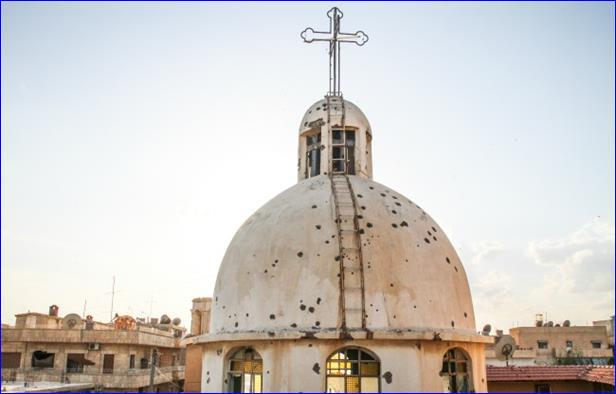The Use and Abuse of Syrian Christians

On 12 February, after a Jabhat al-Nusra suicide attack on a bus carrying Shiite pilgrims in Damascus that killed six and wounded 19, the Syrian Army raised checkpoints throughout the area, and together with Hezbollah cordoned off Shiite shrines in the city.
But when the Islamic State (ISIS) kidnapped 220 Assyrian Christians from northeastern Syriain the past few days, nobody rushed to defend them. The kidnappings were carried out during the Kurdish People’s Protection Units (YPG) anti-ISIS campaign in Tel Tamr, where some of their fighters were also captured.
Apparently, the White House and some other chanceries in the West aware of such things. In September last year, US President Barack Obama reportedly told a delegation of Eastern Christian patriarchs that the Syrian government “protected Christians in Syria.” Whether he was being sarcastic, or he genuinely believed this to be true, it was a slap in the face for Syrian Christians.
Nobody really defends their community or their churches; there are very few secular rebels who understand the political value of doing so.
Otherwise, how is that ISIS kidnaps 220 Christians, but has never been able to take 220 Shiite or 220 Alawites hostage?
The Christians in Syria are definitely a target for the Islamic State. No one doubts it. The kidnapping and execution of 220 Syrian Army soldiers would not make headlines in mainstream media the way 220 kidnapped Christians would. But it’s also an interesting strategy for the Syrian-Iranian alliance to use the Christian community in Syria as bait.
Syria’s Christians, as a community, did not get involved in the Syrian civil war. They did not form a militia to fight against or with the regime. There were, indeed, Christians supporting the political opposition; Syrian Christians in exile are working to help Syrian refugees, setting up websites and Facebook pages to counter the regime’s propaganda. Some Syrian Christians felt oppressed by the Assad regime, especially its police state.
Nevertheless, supporting the Sunnis in their anti-Assad regime movement was not an option either. They were not devoted Assad supporters, but they were afraid. In conflict, the communities that take a neutral stance are usually the first to be attacked in a civil war — simply because nobody protects them.
Other than a small number of Kurdish fighters, nobody protected the Christians of Hasakah. The Kurds picked up weapons and fought to protect their own community — they were between taking and not taking sides. The Christians, with very few exceptions, did not. Most of them believed that the Assad regime and the state’s army would defend them, since they were a minority group that did not create problems for the government.
But in fact, the regime has been using them to prove to the West that their government is a better option than the opposition. Attacking, kidnapping and killing Christians in Syria has always made headlines in Western media.
The Syrian government’s strategy became clear in the summer of 2013, during the siege of Maaloula, a Christian town 60 kilometers north of Damascus. Syrian rebel brigades captured it because of its strategic location close to the main road that links Damascus and Homs. But Maaloula was even more valuable for a different type of strategy: damaging the image of the rebels.
Rumors began to circulate that Al-Qaeda-linked rebels were seeking to force Christians to leave Syria because they wouldn’t join them in fighting Assad loyalist forces. But the battle of Maaloula made things worse. Many of the town’s residents fled to Damascus. The media was told that Nusra Front fighters had desecrated churches when it kidnapped 12 nuns from a monastery (although journalists were unable to verify reports of desecration).
“The town’s residents fled in a hurry to Damascus when the rebels first moved in. They are very upset and angry about what happened,” BBC’s Jeremy Bowen reported at the time. “Some told me that when they left, the Al-Nusra Front desecrated some of their churches. There is quite a bit of damage to the town, but I can’t see considerable damage to the holy places. In fact, I can see a big statue of the Virgin Mary that is very much intact.” The nuns of the Maaloula monastery were released in a prisoner swap with the Syrian government, but they said they were never harmed by the rebels.
Since then, the Nusra Front has been very careful when dealing with the Christian community. The al-Qaeda-linked rebels kidnapped a priest and 20 members of his parish in October 2014 over a property dispute, but they were released within days unharmed.
The Islamic State is another matter. The jihadists have been ruthless with other sects and the Christians, who don’t have their own militia to defend themselves, have been easy prey. Executions in northern Iraq, especially after the fall of Mosul, also boosted the group’s fame for ruthlessness and excessive cruelty.
The United Nations Committee on the Rights of the Child released a report last year, which revealed that ISIS was systematically killing, torturing, raping, beheading, crucifying, and burying alive children and families from the Yazidi sect and Christian communities.
This was terrible news for the Western world, but great news for the Iranian-Syrian alliance. News like this proves their propagandizing that the Syrian rebels, as a whole, are barbaric jihadists who want to eliminate all groups except Sunnis. Where the Nusra Front failed, ISIS succeeded.
The West is terrified, and that is what both groups wanted from the beginning. The abuse of Christians is a great marketing strategy for both the Islamic State and the Syrian-Iranian alliance. The Islamic State proves to fanatics worldwide that massacring Christians is possible, and they also entice other affiliated groups to do the same. The Syrian-Iranian alliance can also grin, because this way, they prove to the West that they’re the “better choice.”
After all, the massacre of 10 children in Ratyan didn’t make such big waves.
© Assyrian International News Agency.
